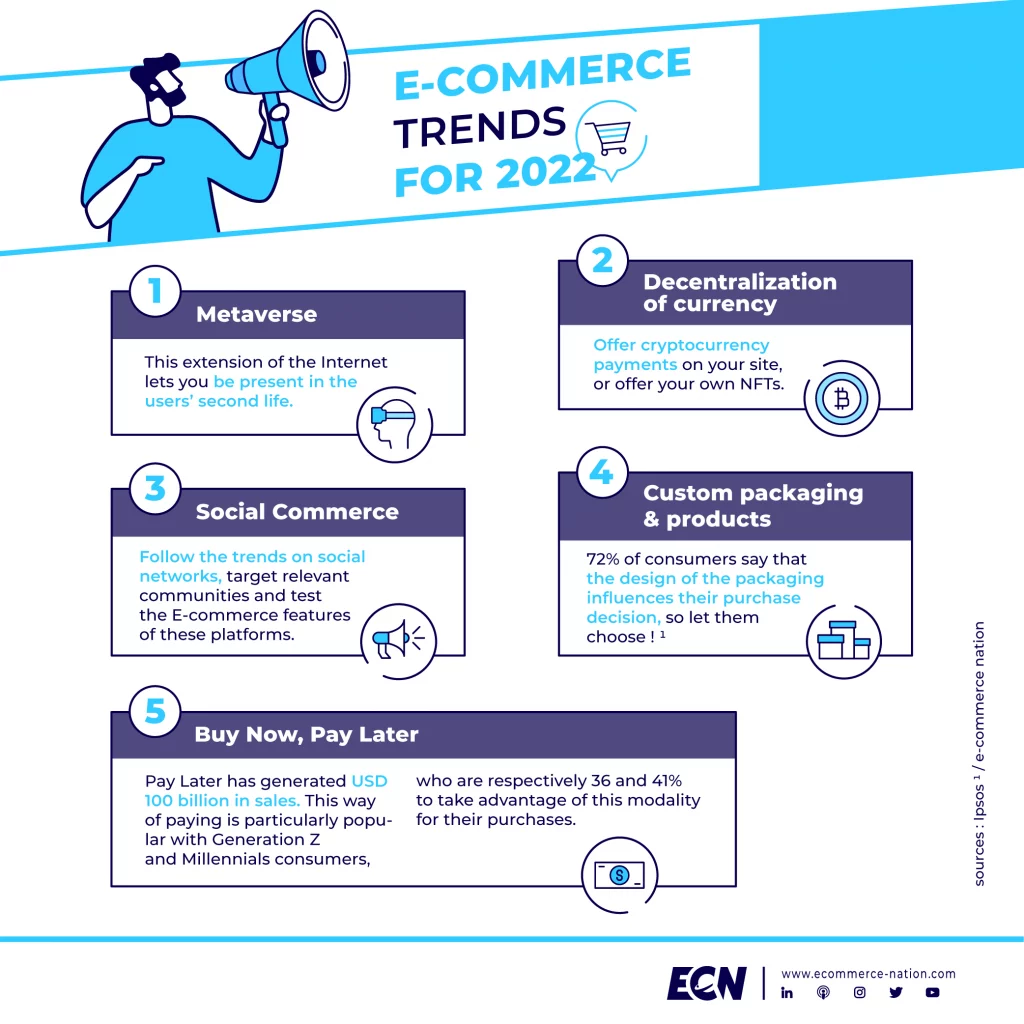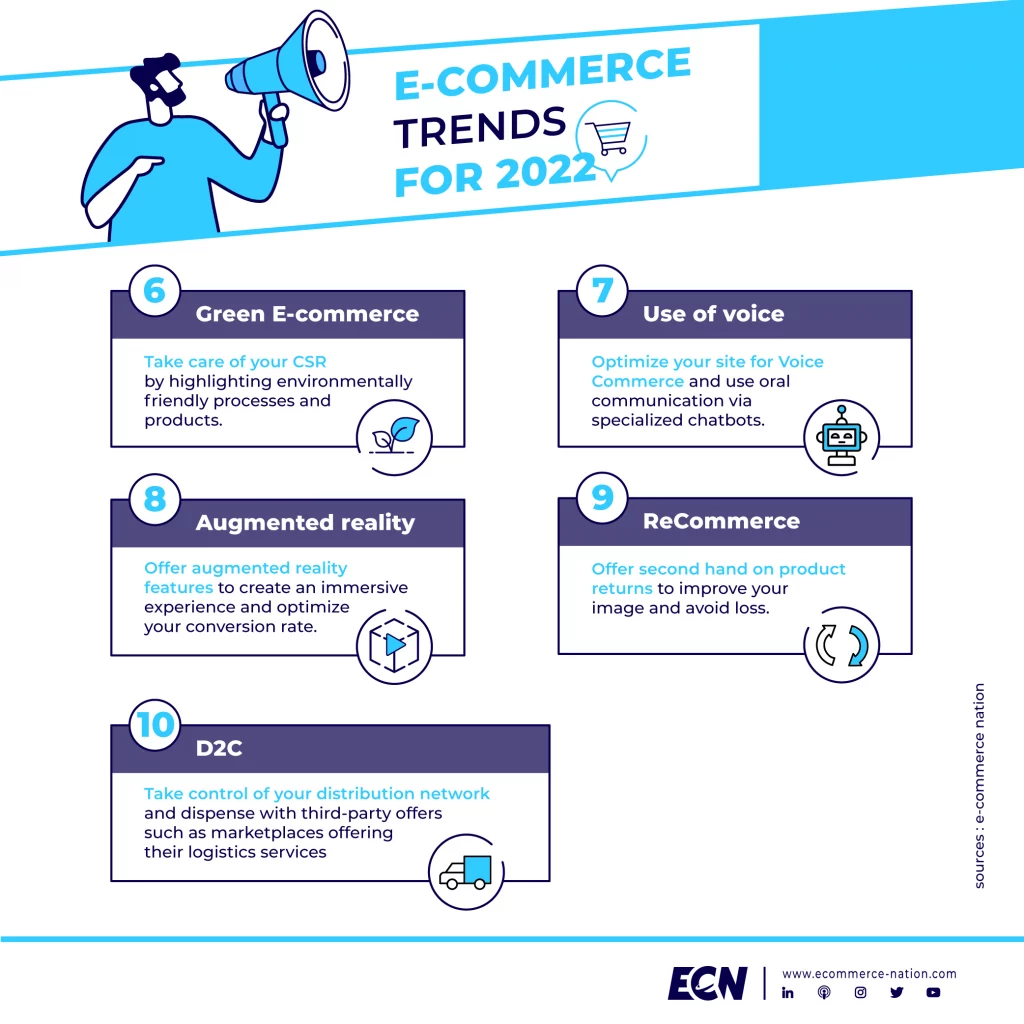The last two years have left their mark on the world, and the E-commerce industry is no exception. The particular situation has led some companies to identify new E-commerce trends and adopt new processes. According to Statista, E-commerce sales have exceeded USD 4.2 trillion worldwide. The pandemic and the natural development of online sales explain this 25% increase compared to the previous year.
In particular, health restrictions have led consumers to buy more and more on the Internet. This represents an opportunity for online retailers to take advantage of this strong acquisition, and to turn new customers into loyal ones.
In this article, we will identify the upcoming E-commerce trends for the year 2022. These will allow you to promote your business, its products, helping you attract more consumers to your site. Then, we are going to give you some trends allowing you to ensure a good conversion rate to your online store, then to retain these converted customers. To conclude this article and give you a summary of these E-commerce trends, we propose an infographic.
#1 Metaverse
Facebook has, when announcing its name change to Meta, greatly promoted the metaverse. This Internet extension is the current equivalent of the second life. Its applications are infinite, from virtual meetings with colleagues to entertainment with friends. It is therefore widely applicable to E-commerce.
Indeed, it is possible to create your own store on the metaverse. As for a physical store, it will be possible to set up a strategy of dramatization, of the offer more precisely than on a lambda site, in particular thanks to merchandising. The approach can also be more customized.
On these platforms, purchases are made with virtual currencies, and allow you to enjoy a second life.
#2 Cryptos and NFTs
We’ve been hearing a lot about crypto-currencies and NFTs for the past few years.E-commerce is gradually starting to offer features related to these decentralized payment themes.
You can now give consumers several choices: credit card, wire transfer, or even crypto-currency. It is therefore possible to come across online stores offering payment by Bitcoin or Ethereum.To go further in the exploitation of alternative means of payment, it is now possible to access a bank card, called a crypto-debit card. This one allows you to pay directly in the physical and virtual worlds by taking from your wallet dedicated to crypto-currencies.
In addition to crypto-currency payments, there is a trend around NFTs. These immaterial works, whose ownership can be claimed to whoever wants to pay for it, can for example today be sold directly on the SaaS CMS, Shopify. The Ebay marketplace is also looking into this possibility.
#3 Live Shopping & Social Commerce
The people attached to physical commerce are particularly attached to it because of the relational capacity of this consumption channel, as well as the advice provided by the sales force present on site.
A new trend in retail media allows to create a live relationship, thanks to video. Specifically, this feature popular with younger consumers is born from the fusion of the physical world and the rise of streaming (5 billion hours for Twitch in 2021, according to StreamElements).
The concept was introduced in China by Alibaba and popularized by Burberry in 2016 with its See Now, Buy Now. Burberry is one of the luxury brands that has invested the most in its digital development, being 5 years ahead of the live shopping concept. Once again, the objective is to reach young generations, who are very fond of live formats.
Social networks are still at the center of a large part of digital strategies. The year 2021 has not lacked news on these social networks. In particular, we can mention the decision of the Facebook group to change its name to “Meta” and create its metaverse, regrouping all its brands (social networks and instant messengers).
In the last few years, we have also seen the rise of a Chinese social network, particularly affecting younger consumers. They are the future target of online stores, which must now adapt to their needs, understand their codes and offer adapted products.
The social dimension is particularly important in the world of e-commerce. It allows to compensate for the lack of human contact during an online shopping session. Social networks are therefore increasingly offering E-commerce features directly on their platform.
Among these, we can mention the success of Pinterest. Indeed, 97% of users use the platform to find shopping inspiration, proving the huge commercial potential of the network. The objective is not to promote the brand, but to propose inspiring content, with products adapted to the searches. Another example is Instagram, which also offers in-app purchases of promoted products.
#4 Custom packaging & products
Packaging is also part of the customer experience. Even if the discovery of the packaging is in the post-purchase phase, it is of great importance and represents an additional opportunity to build consumer loyalty by enchanting the reception of the product.
First impressions count, and packaging is what it represents in the physical world. It is the first contact that the consumer will have with your product, in addition to the physical contact made on your online store during their purchase. Packaging is part of the experience your company sells, and therefore, part of the overall universe of your brand.
According to an Ipsos study done in the United States, 72% of consumers say that the design of the packaging influences their purchase decision, thus representing a major vector of E-commerce loyalty.
You must therefore create excitement and enthusiasm around the reception of your product by personalizing the packaging. Consumers feel taken into account and understood by your brand. This helps you to create a very strong link with them.
In addition to packaging, you can go further in the customer experience and offer custom products. Here, the objective is to offer a product adapted to the consumer’s requests. To do this, you need to adapt your online store and your product sheets to provide the possibility to customize the visitor.
Then, you must adapt your supply chain to ensure that the consumer’s requests will be met when they receive their product. To do this, you need to choose the right suppliers, who will then be able to make changes to the products on demand.
According to Deloitte, 22% of consumers are willing to share more of their data to get customized products and experience. Personalization allows you to optimize the shopping experience so that it exactly meets the expectations of your visitors, increasing your conversion rate on your online store.
#5 Buy Now, Pay Later
In order to facilitate consumption, more and more online stores are offering Pay Later. This payment method allows you to create a payment schedule when making a purchase. It consists in getting the product directly and paying it later.
According to Forbes, Pay Later has generated USD 100 billion in sales. This way of paying is particularly popular with Generation Z and Millennials consumers, who are respectively 36 and 41% to take advantage of this modality for their purchases.
This modality follows in particular the payment several times which also allows to increase the conversion rate and the average cart.

#6 Green E-commerce
Ecological and social issues are increasingly taken into account by consumers. They are now more interested in the environment, especially in the way they buy.
This involves several things. One example is local consumption, which has also become particularly popular during the pandemic and the health restrictions. Consumers are interested in local solutions to eat better, dress better, … So if you offer local products to consumers around your location: tell your customers! You can go as far as storytelling around your product and your company.
Also propose alternative delivery solutions, such as delivery by drone, last mile by bike, electric vehicle, … You have many solutions to optimize your influence on global warming and limit your impact on the environment.
Finally, we have previously talked about packaging. You can propose eco-friendly packaging, both by the materials used and by their possibility of recycling / reuse.
#7 Use of voice
We’ve been hearing about Voice Commerce for a few years now.It is becoming a part of our lives as voice assistants develop and the number of features increases.It is becoming part of our lives with the development of voice assistants, their increasingly affordable prices and the multiplication of functionalities (especially those related to e-commerce). It is indeed possible today to order products directly by making a request to your connected speaker.
The Voice can also be used in the customer relationship, without it being yours. Indeed, bots are more and more present in the e-commerce world, and today propose interaction by voice. This allows you to answer consumers’ questions passively. On top of that, this solution is cheaper than using call centers.
#8 Augmented Reality
Augmented reality is one of the major technological developments of the last few years. In constant development, this technology now meets several uses, and the e-commerce industry is no exception. Like virtual reality, augmented reality is slowly making its way into the lives of consumers, whether for entertainment purposes or for shopping.
AR bridges the gap between reality and the digital world, and is more easily portable. Its E-commerce applications are diverse, and can be used in various industries. Specifically, it is relevant in the fashion and furniture industries. The augmented reality experience enchants the customer’s purchase, who can then preview the product on him or in the place of his choice.
There are 4 augmented reality technologies:
- Marker-based
- Markerless
- Location-based
- Projection-based
#9 ReCommerce
Let’s go back to the notion of Green E-commerce. This includes what is called ReCommerce. What does this mean? ReCommerce represents the application of the circular and second-hand economy in E-commerce. This concept has largely been developed in correlation with the progressive consideration of the state of our planet.
In particular, ReCommerce represents an opportunity for customers to start selling products they no longer use. When this kind of sale is made, it is called C2C (Consumer to Consumer). We can observe various sites putting forward this type of sale, like Vinted.
Professionals can also apply ReCommerce, like a large number of big brands today. The objective is to benefit to its CSR, and to take advantage of the consumers’ returns to put forward the products. In addition to promoting your ability to meet the eco-responsible demands of consumers, it promotes your company’s product return policy.
This modality is particularly appreciated by Generation Z, which is a current and future part of your target audience.
#10 D2C
What is D2C? It’s an extension of B2C commerce that consists in cutting out a part of the distribution steps, and selling the product directly to the consumer. Hence its name: Direct to Consumer.
This modality requires a takeover of the distribution process by the merchants. This is particularly applicable in a local business, which would like to highlight its eco-responsibility.
The merchant, entirely in charge of his distribution network, saves money by not having to deal with logistic modalities.
Finally, this way of distributing its products allows it to be closer to its consumers while promoting its brand image more easily.

via https://www.aiupnow.com
Thibault Herpin, Khareem Sudlow


